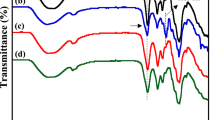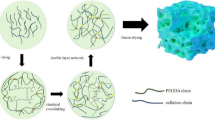Abstract
An experimental investigation is performed on proton conducting polymer gel electrolyte nano-composites based on cellulose acetate, dispersed with nano-sized titanium dioxide (TiO2) particles. The nano-composite polymer gel electrolyte systems are in the form of a highly viscous gel. The optimized material, with 7.0 wt% TiO2, offers the highest electrical conductivity of 1.37 × 10−2 S cm−1 at room temperature (30°C) and also possesses the lowest activation energy. This gel was used to assemble a proton battery with the configuration Zn/gel/MnO2 + PVdF + acetylene black. A discharge capacity of 60.1 and 54.1 mA h is observed when the cells are discharged at a constant current of 0.5 and 1.0 mA, respectively. Both electrical and electrochemical studies demonstrate promising characteristics for these composite polymer gel electrolytes, making them suitable as electrolytes in proton batteries.
Similar content being viewed by others
Explore related subjects
Discover the latest articles, news and stories from top researchers in related subjects.Avoid common mistakes on your manuscript.
Introduction
A general battery configuration is given by the combination anode/electrolyte/cathode. The electrolyte is the critical component through which the ions move from the cathode to the anode or vice versa, giving rise to an electrochemical reaction and resulting in the development of a potential between the cathode and anode. The electrolyte should ideally be an excellent ionic conductor, a poor electronic conductor, rigid, leak proof and capable of making good electrode–electrolyte contact to accommodate volume changes during charge–discharge cycles. To achieve the last criterion, the electrolyte needs to be flexible or gel-like, which contradicts the other requirements. Therefore, a compromise has to be sought in the development of a suitable material and the best compromise is to use either a solid polymer electrolyte or a polymer gel electrolyte (PGE).
The choice of electrolyte depends upon the mobile ion H+, Li+, and Na+ etc. and the electrochemical efficiency depends on the power and voltage obtainable from the battery. Li+-based batteries are electrochemically the most efficient. Therefore, many studies on batteries with Li+ ion conductors have been undertaken [1, 2]. The choice of Li+-based batteries arises from the availability of good lithium ion conductors and a large electrochemical stability window [3]. However, lithium ion batteries have several disadvantages such as high cost, difficulty in handling lithium electrodes and safety hazard. Recently, many attempts to develop proton conductors have been conducted due to their safety and low cost [4–6]. Hence, a commercially viable and cost-effective proton battery becomes possible.
In spite of their smaller electrochemical stability window compared with Li+ batteries, substantial progress has been made in the development of new proton conductors with high ionic conductivity. The electrochemical window for a proton battery generally is between 1 and 2 V. Proton batteries do not have the highest power density but the availability of low cost proton conductors has made proton batteries a good alternative for low energy density battery applications [7]. A successful proton battery needs an anode capable of supplying or injecting H+ ions into the battery electrolyte, a proton conducting electrolyte and a cathode. In this study, attention has been focused on the influence of titanium dioxide, as filler, on the electrical and electrochemical properties of composite polymer gel electrolytes (CPGE) and their potential as an electrolyte in proton batteries.
Experimental
Cellulose acetate (CA) and ammonium tetrafluoroborate (NH4BF4) procured from Fluka, USA were used as the host polymer and doping salt, respectively. Dimethylformarmide (DMF) obtained from UNIVAR, Australia was employed as the solvent. Nanoceramic powders of TiO2 (particle size ~20 nm) were obtained from Aldrich, Germany and used as filler. All these materials were used as received. Liquid electrolytes were prepared by direct dissolution of 0.4 M NH4BF4 in DMF. CA, as a polymeric gelling agent, was added to the liquid electrolyte with different weight ratios, in order to convert the electrolytes into gels. The mixture was stirred at room temperature for 24 h until a homogeneous solution was obtained. The CPGE was prepared by subsequently adding TiO2 to the PGE that exhibited the highest conductivity.
The highest ionic conductivity CPGE (weight: 0.35 g) was used in the fabrication of the electrochemical cells. The anode pellet, which has an area of 4.71 cm2, weight 0.5 g and thickness ~0.15 cm, was prepared by hydraulic pressing. Zinc powder (Zn, UNIVAR)/Zinc sulphate (ZnSO4.7H2O, UNIVAR)/polyvinylidene fluoride (PVdF, Fluka)/acetylene black (AB, Denka Singapore) (80:10:6:4 weight ratios) were mixed together to form the anode pellet of the battery. The cathode pellet, which has an area of 4.71 cm2, weight 0.5 g and thickness ~0.15 cm, was prepared using the same method. The cathode material consisted of manganese dioxide (MnO2) (Aldrich)/PVdF/AB (80:12:8 weight ratio). PVdF acted as the binder while stainless steel mesh inserted inside the cathode and anode pellets acted as the current collectors. The cell was assembled and characterized for its open circuit voltage (OCV) and discharge characteristics using a WBCS 3000 battery cycler (WonA Tech, Korea).
Results and Discussion
PGEs were obtained by adding CA polymer to the liquid electrolytes. Although the DMF + 0.4 M NH4BF4 + 1.0 wt% CA PGE exhibited the highest conductivity, 9.89 × 10−3 S cm−1 (see Table 1), good physical properties also govern their practical applicability.
Therefore, various proportions of TiO2 were introduced into the highest conducting PGE in order to obtain CPGEs. The addition of nanoceramic particles results in an increase in conductivity and two maxima peaks were observed in the conductivity variation, as shown in Fig. 1. Similar behaviour has earlier been reported for some Li+ and NH4 + ion PGEs dispersed with nanoceramic particles [8, 9].
The occurrence of the first conductivity maximum (1.08 × 10−2 S cm−1) is possibly related to the dissociation of ion aggregates from the salt into free NH4 + ions with the addition of TiO2 and, as a result, the conductivity increases for 3 wt% addition of ceramic particles. The presence of the second conductivity maximum (1.37 × 10−2 S cm−1) is possibly due to the large interfacial layer between the dispersed ceramic particles and the PGE. At higher filler concentrations, the ceramic particles get close to each other so that the blocking effect becomes large and the conductivity starts to fall.
Figure 1 also depicts the variation of activation energy (E A) with the amount of TiO2 filler added in the preparation of the CPGE. It shows that the electrolyte exhibiting the highest electrical conductivity has the lowest E A. Higher E A means that more energy is required to be conducive to the migration of ions [10]. The E A for the CPGE is calculated from the gradient of the log of the conductivity-temperature plot and is given in Fig. 2.
A temperature dependence study of the ionic conductivities of the PGEs was carried out in order to understand the mechanism of ionic conduction. Figure 2 shows the result of the variation of conductivity in the temperature range 303 to 373 K. The conductivity for all samples increased with increasing temperature and was almost linear, suggesting that the conductivity obeys the Arrhenius rule and is thermally assisted. There are no abrupt changes in conductivity, which suggests that there is no phase transition in the polymer matrix.
Figure 3 shows the OCV of the cell as a function of time at room temperature. The cell was fabricated using the Zn|DMF-0.4 M NH4BF4-1.0 wt% CA–7.0 wt% TiO2|MnO2 configuration. After fabrication, the cell was initially allowed to settle down for 5 min and thereafter the voltage values were recorded as a function of time. The OCV characteristic of the cell at room temperature (30°C) shows that the initial voltage of the cell is 1.55 V, dropping to ~1.40 V within the first 2 h of assembly. The cell voltage was observed to have stabilized at this voltage and the OCV remained constant at 1.40 V for a period of 24 h. We can conclude from this that the fabricated cell is reasonably stable in the open cell condition. The immediate drop in voltage of the cells after fabrication, within first 2 h, is due to the stabilization of the cell formation reaction at the electrodes.
The discharge characteristics of the cell with 0.50 mA and 1.00 mA loads at room temperature (30°C) are given in Fig. 4. When discharged with a low load current (0.50 mA), the voltage-capacity curve exhibits a rapid initial fall and then remains stable at ~1.30 V, reaching a cut-off of 0.70 V after 120.2 h and giving an approximate discharge capacity of 60.1 mA h. For a discharge current of 1.00 mA, the discharge was sustained for 54.1 h until the cut-off voltage reached 0.70 V. The discharge capacity under this condition was 54.1 mA h. As expected, the discharge capacity for low current drain (0.50 mA) was higher than that obtained for higher current drain (1.00 mA). The discharge capacities obtained using this CPGE are higher than those reported in literature [4], which is 17.0 mA h for batteries using only chitosan-based PGE. The specific power for the cell can be calculated and gives 0.48 and 0.96 W kg−1 (entire cell weight) at 0.50 and 1.00 mA loads, respectively. The specific energy for each load is 57.7 and 51.9 Wh kg−1 (entire cell weight).
Conclusion
The addition of TiO2 nanoceramic particles has resulted in an increase in conductivity of PGE. The highest conductivity attainable for TiO2 based composites is at 7.0 wt% of TiO2 and its value is 1.37 × 10−2 S cm−1. The OCV of ~1.40 V for the TiO2 based CPGE was obtained and this remains stable for more than 24 h. The discharge capacities were 60.1 mA h for a discharge current of 0.50 and 54.1 mA h for a discharge current of 1.00 mA. This leads us to conclude that CPGE has been obtained by adding NH4BF4 and TiO2 to CA makes this material a potential candidate as an electrolyte in proton batteries.
References
Mohamed SN, Johari NA, Ali AMM, Yahya MZA (2008) Electrochemical studies on epoxidised natural rubber-based gel polymer electrolytes for lithium–air cells. J Power Sources 183:351–354
Rao MM, Liu JS, Li WS, Liang Y, Zhou DY (2008) Preparation and performance analysis of PE-supported P(AN-co-MMA) gel polymer electrolyte for lithium ion battery application. J Membrane Sci 322:314–319
Chandra S (1981) Superionic solids: principles and applications. Elsevier North Holland, Amsterdam
Ng LS, Mohamad AA (2006) Protonic battery based on a plasticized chitosan-NH4NO3 solid polymer electrolyte. J Power Sources 163:382–385
Kadir MFZ, Majid SR, Arof AK (2010) Plasticized chitosan-PVA blend polymer electrolyte based proton battery. Electrochim Acta 55:1475–1482
Tominaka S, Akiyama N, Croce F, Momma T, Scrosati B, Osaka T (2008) Sulfated zirconia nanoparticles as a proton conductor for fuel cell electrodes. J Power Sources 185:656–663
Nakajima H, Honma I (2002) Proton-conducting hybrid solid electrolytes for intermediate temperature fuel cells. Solid State Ion 148:607–610
Johari NA, Kudin TIT, Ali AMM, Winie T, Yahya MZA (2009) Studies on cellulose acetate-based gel polymer electrolytes for proton batteries. Mater Res Innov 13:232–234
Singh B, Kumar R, Sekhon SS (2005) Conductivity and viscosity behaviour of PMMA based gels and nano dispersed gels: role of dielectric constant of the solvent. Solid State Ion 176:1577–1583
Latif F, Aziz M, Katun N, Ali AMM, Yahya MZA (2006) The role and impact of rubber in poly(methyl methacrylate)/lithium triflate electrolyte. J Power Sources 159:1401–1404
Acknowledgment
N. A. Johari would like to thank MOSTI for Skim Pascasiswazah scholarship awarded. This study was supported by MOSTI under grant E-Science 03-01-01-SF0022.
Author information
Authors and Affiliations
Corresponding author
Rights and permissions
About this article
Cite this article
Johari, N.A., Kudin, T.I.T., Ali, A.M.M. et al. Electrochemical Studies of Composite Cellulose Acetate-Based Polymer Gel Electrolytes for Proton Batteries. Proc. Natl. Acad. Sci. Sect. A Phys. Sci. 82, 49–52 (2012). https://doi.org/10.1007/s40010-012-0005-0
Received:
Accepted:
Published:
Issue Date:
DOI: https://doi.org/10.1007/s40010-012-0005-0








